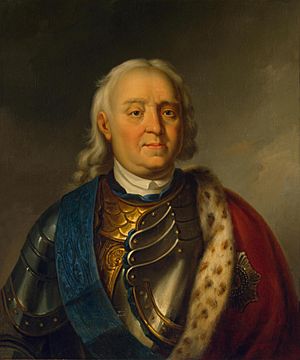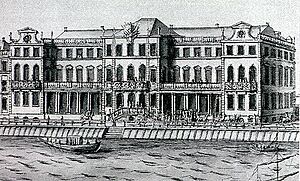Fyodor Apraksin facts for kids
Quick facts for kids
Fyodor Apraksin
|
|
|---|---|
 |
|
| Born | October 27, 1661 |
| Died | November 10, 1728 (aged 67) |
Fyodor Matveyevich Apraksin (born October 27, 1661, died November 10, 1728) was an important figure in Russian history. He was one of Russia's very first admirals. He helped Peter the Great build the Russian navy. Apraksin also served as a governor and led the Baltic Fleet. He was a close friend of Peter the Great throughout his life.
Contents
Early Life and Building Ships
Fyodor Apraksin's family became well-known when his sister Marfa married Tsar Feodor III of Russia in 1681. Fyodor started working for the Tsar when he was just 10 years old. After Tsar Feodor died, Apraksin continued to serve the young Tsar Peter.
He joined Peter in his military games. He even helped Peter build a small "toy" fleet of ships. Their friendship lasted their whole lives.
In 1692, Apraksin became the governor of Arkhangelsk. This was Russia's main trading port at the time. He helped build strong ships there. These ships could handle rough seas, which made the Tsar very happy. He also helped build one of the first Russian trade ships to sail to other countries.
Later, in 1697, Apraksin was put in charge of building many ships in Voronezh. Here, he oversaw the creation of Russia's first real navy. He became a colonel during the siege of Azov in 1696. In 1700, he was named the first Russian governor of Azov. While Peter the Great was fighting Charles XII of Sweden, Apraksin was busy building fleets, forts, and harbors in southern Russia. These included places like Tavrov and Taganrog. From 1700 to 1706, he was also the head of the Admiralty. His skill in building things was very helpful.
Leading in the Great Northern War
After helping to calm a rebellion in Astrakhan, Apraksin was called to Moscow. There, he took charge of the mint (where money is made) and the armory (where weapons are stored). In 1707, he became the president of the Russian Admiralty.
The next year, he was made commander-in-chief in Ingria. His job was to protect the new capital city, Saint Petersburg, from the Swedes. He defeated them completely. On February 25, 1710, when he was 48, he became a count. This was a very high honor. In March 1710, he led the siege of Vyborg. After capturing this Swedish fortress in June, he received a special award called the Order of St. Andrew. He was also made governor of the areas Russia had won, including Estonia, Ingria, and Karelia.

Apraksin was the main commander in the Black Sea during the Pruth campaign in 1711. He led the Imperial Russian Navy in capturing Helsinki in 1713. His actions from the sea greatly helped Russia conquer Finland. He also played a big part in the important Battle of Gangut in 1714. That same year, he helped the Tsar open a new naval harbor in Reval (now Tallinn, Estonia). Earlier, in 1712, he talked with Turkey. This led to the destruction of Taganrog and Russia giving Azov back to the Ottomans.
From 1710 to 1720, he personally led attacks on Sweden. These attacks caused a lot of damage to the country. This helped force Sweden to sign the peace of Nystad treaty. Through this treaty, Sweden gave up much of its land along the Baltic Sea to Russia. For these great services, Apraksin became a senator and a General Admiral of the Russian Empire.
Later Years and Legacy
In 1715, Apraksin had some problems with the Tsar. The Tsar had heard about issues in the Admiralty. After a short investigation, Apraksin was fined and sent to govern Estonia. In 1719, he led a Russian naval trip into the Gulf of Bothnia. During the Russo-Persian War (1722-1723), Apraksin narrowly escaped an attack by a Chechen.
While his older brother, Peter Apraksin, was accused of supporting Tsarevich Alexei Petrovich, Fyodor was very eager to show his loyalty to the Tsar. He helped in the investigation against the Tsarevich.
After Peter the Great died in 1725, his wife Catherine became Empress. She gave Apraksin another special award, the Order of St. Alexander Nevsky. She also named him to the Supreme Privy Council. This was a new group of powerful leaders who helped the Empress rule.
Apraksin's last naval trip was to Revel in 1726. He went there to protect the town from a possible attack by the British government. Relations between Russia and Britain were tense at the start of Empress Catherine I's rule.
Even though Peter the Great often threatened Apraksin for his problems with money, Apraksin always managed to avoid serious punishment. This was mostly thanks to the kind Empress Catherine I. She was Peter I's wife and later became the sole ruler of Russia from 1725 to 1727. She remained his friend until the end. She was likely grateful because he helped her become Empress after Peter's death.
According to historians, Apraksin was one of Peter the Great's kindest and most friendly students. It is said that he never made an enemy. He passed away on November 10, 1728, at the age of 67. He was buried in his family's tomb in the Chrysostom Monastery in Moscow. Sadly, his grave was destroyed in the 1930s.
See also
 In Spanish: Fiódor Apraxin para niños
In Spanish: Fiódor Apraxin para niños

